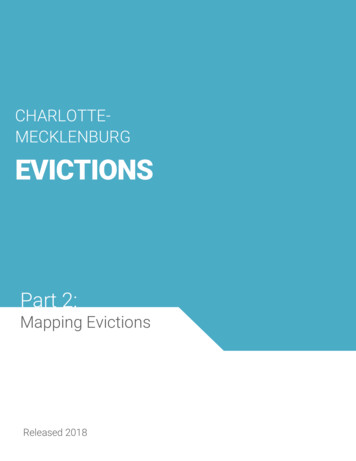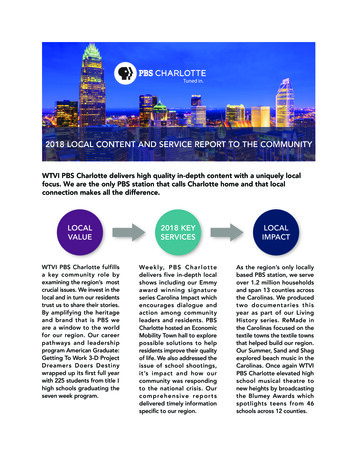
Transcription
Charlotte-MecklenburgEmergency Shelter SystemASSESSMENT OF CAPACITY & UTILIZATIONRELEASED APRIL 2019PREPARED BY MECKLENBURG COUNTY IN PARTNERSHIP WITH UNITED WAY OF CENTRAL CAROLINAS
CONTENTS04EXECUTIVE SUMMARY06INTRODUCTION & OVERVIEW08CHARLOTTE-MECKLENBURG CONTEXT12THE EMERGENCY SHELTER SYSTEM INCHARLOTTE-MECKLENBURG14DEVELOPING A FRAMEWORK TO EVALUATETHE EMERGENCY SHELTER SYSTEM29EMERGENCY SHELTERS AS A SYSTEM34TOWARD AN OPTIMAL EMERGENCY SHELTERSYSTEM35APPENDICES
AuthorsCOURTNEY MORTONSHIRAIN BANNERMECKLENBURG COUNTYCOMMUNITY SUPPORT SERVICESUNC CHARLOTTEReport ReviewersADELAIDE BELK, UNITED WAY OF CENTRAL CAROLINASKATHY BRAGG, COMMUNITY SHELTER OF UNION COUNTYLAURA CLARK, UNITED WAY OF CENTRAL CAROLINASLIZ CLASEN-KELLY, MEN'S SHELTER OF CHARLOTTEKATHRYN FIRMIN-SELLERS, UNITED WAY OF CENTRAL CAROLINASTRISH HOBSON, THE RELATIVESSTACY LOWRY, MECKLENBURG COUNTYSTEPHEN MCQUEEN, URBAN MINISTRY CENTERDERONDA METZ, SALVATION ARMY CENTER OF HOPECHANDA SCOTT, SAFE ALLIANCEThis report was completed by Mecklenburg County Community Support Services in partnershipwith United Way of Central Carolinas. Many thanks to the emergency shelter providers inCharlotte-Mecklenburg and Union County for supporting this effort.
EXECUTIVE SUMMARYEach day, emergency shelters in Charlotte-Mecklenburg must turn away people who are facing ahousing crisis: single adults, families, youth, veterans and individuals as well as those who havebeen displaced due to natural disasters. The reality that local emergency shelters are full is notnew; these shelters have always been at the front lines of serving those who need immediate help.The need for shelter is always the end result of a loss of housing. To adequately address the needfor shelter, the community must also consider permanent, affordable housing as central to thesolution.In Charlotte-Mecklenburg, there is and has been an indisputable shortage of housing affordable tothose earning less than median income levels. While investment in both short- and long-termhousing subsidies has increased since 2010, finding units to match with available subsidies inCharlotte-Mecklenburg has been challenging. In addition, the number of naturally occurringaffordable housing (NOAH) units, where subsidies are not needed, is decreasing due to marketpressures.The need for affordable housing has grown out of proportion to the supply of all housing, as well.Over 75,000 renter households in Charlotte-Mecklenburg face housing instability because they arecost-burdened. In addition to those households facing a high risk of experiencing homelessness,on average 711 households call NC 2-1-1 for housing assistance each month; of these, 318households receive an in-person assessment through the community’s Coordinated Entry system.Over 5,000 individuals entered emergency shelter during FY17. This does not capture the numberof people turned away.The solution for housing instability and homelessness is the same: housingthat is affordable to individuals and families at all income levels.4
Readily available, affordable housing, especially for those earning at or below 30% of area medianincome would help address capacity issues in shelters. However, even when there is enoughhousing affordable to anyone, communities must have a crisis response system to help individualsand families access shelter when they need it. Therefore, Charlotte-Mecklenburg must considerwhether existing emergency shelters are both effectively providing immediate, safe space for alland efficiently connecting individuals and families with housing available.The emergency shelters, if functioning as a coherent system in Charlotte-Mecklenburg, areuniquely positioned to play a significant role in the work to end and prevent homelessness, andincrease access to affordable housing. Some have begun the difficult work to coordinate andcollaborate across individual shelters and explore complementary services to expand capacitywithout building new facilities.Charlotte-Mecklenburg is not unique in its challenge to create a fully functional emergency sheltersystem. Determining the right number of emergency shelter beds is a question faced bycommunities across the United States. The lack of affordable housing, in combination with otherfactors, contributes to an increased need for permanent housing solutions.The emergency shelter system must effectively provide crisis shelter forthose who most need it and then efficiently connect those in crisis to housing.This report articulates the need to view the emergency shelters as a system, holistically and in itsproper context. Analysis of the Charlotte-Mecklenburg emergency shelter system utilization andcapacity is provided within the larger context of permanent, affordable housing need and supply.To effectively evaluate the emergency shelters as a system, an objective and comprehensiveframework is used to describe the current state and offer recommendations for optimization.Prior to building new shelters, decision makers must consider the impact of implementedsolutions upon overall system performance and optimization. Shelters are necessarily more thanoptions in time of crisis. Only by adopting a coordinated approach, within the broader context ofhomelessness and housing instability, will Charlotte-Mecklenburg truly impact the need foremergency shelter.5
INTRODUCTION & OVERVIEWIn Charlotte-Mecklenburg, there is an indisputable shortage of housing affordable to those earningless than median income levels. According to the National Low Income Housing Coalition, there areonly 32 units available per 100 households at or below 30% of area median income. This equates toincome of about 25,000 a year for a family of four. If a household spends no more than 30% onhousing, this means that 625 per month must cover rent and utilities at that income level.The community is unable to keep pace with the affordable housing demand in CharlotteMecklenburg. Since 2001, only 6,572 total affordable units are completed, pending or underconstruction using the City of Charlotte’s Housing Trust Fund. While investment in both short-termand long-term housing subsidies has increased since 2010, finding units to match with availablesubsidies in Charlotte-Mecklenburg has been challenging. In addition, the number of naturallyoccurring affordable housing (NOAH) units, where subsidies are not needed, is decreasing due tomarket pressures.The need for affordable housing has grown out of proportion to the supply of all housing, as well.Over 75,000 renter households in Charlotte-Mecklenburg face housing instability because they arecost-burdened. This means they spend more than 30% of their household income on rent andutilities. Households earning below 30% of area median income are disproportionately impactedwith over 90% of extremely low-income renter households in Mecklenburg County cost burdened.Almost 30,000 households faced formal eviction proceedings in the last fiscal year.Of those households who are at high risk of experiencing homelessness, on average NC 2-1-1receives 711 calls from households/individuals; 318 households receive an in-person assessmentthrough the community’s Coordinated Entry system. The reasons for seeking housing assistanceinclude multiple factors such as employment, childcare, transportation, mental health andsubstance use, domestic violence, natural disaster and healthcare.Over 5,000 people entered emergency shelter during between October 2016 and September 2017.This does not capture all of the people who are turned away by shelters. The solution for housinginstability and homelessness is the same: housing that is affordable to individuals and families at allincome levels. Readily available affordable housing, especially for those earning at or below 30% ofarea median income, would help address capacity issues across all shelters. However, even whenthere is enough housing affordable to anyone, communities must have a crisis response system tohelp individuals and families access shelter when they need it.INTRODUCTION & OVERVIEW6
Charlotte-Mecklenburg must consider whether its emergency shelters are both effectivelyproviding immediate, safe space for all and efficiently connecting individuals and families withhousing available.Charlotte-Mecklenburg’s emergency shelter providers recognized the need to function as acoordinated emergency shelter system. While other communities across the country face similarchallenges, it is not sufficient to look to peer cities to discern emergency shelter solutions inCharlotte-Mecklenburg. Factors like climate, housing market, migration into and out of thecommunity, economy, policy, resources and local priorities play a significant role and combine tocreate a unique environmental context for each community.Therefore, this report will articulate the need to view the emergency shelter system holistically andin its proper context. Additionally, it will discuss how this lens can best position the emergencyshelters in Charlotte-Mecklenburg to serve the individuals and families who will always have a needfor supports in times of personal crisis.INTRODUCTION & OVERVIEW7
CHARLOTTE-MECKLENBURG CONTEXTIn Charlotte-Mecklenburg, over 5,000 people experienced sheltered homelessness, whether inemergency shelter or transitional housing, between October 1, 2016 and September 30, 2017. On asingle night in January 2018, 1,668 individuals experienced homelessness. Most (1,151 or 68%) were inemergency shelter. In 2018, roughly 700 people each month called NC 2-1-1, which is the first step forthose seeking shelter and housing resources. NC 2-1-1 made about 650 monthly referrals for an inperson Coordinated Assessment, which is conducted when the caller reports they are literallyhomeless or at imminent risk of homelessness. Of that number, an average of 318 households camein person each month to receive a full Coordinated Assessment, which might result in a referral to ashelter or the provision of diversion assistance.According to the 2018 Point-in-Time Count, the majority (63% or 1,049) of people experiencinghomelessness are single adults. Families with children represent 32% (535) of all people experiencinghomelessness. Unaccompanied youth (77) and unaccompanied children (5) comprise 5%, which ismost likely an undercount of all the youth experiencing homelessness in the community. Nationally,1 in 10 young adults ages 18 to 25 and 1 in 30 adolescents ages 13 to 17 experience homelessnessduring the course of a year. During the 2017/2018 school year, there were 4,598 students identified aseligible for McKinney-Vento services in Charlotte-Mecklenburg schools.Seventy-nine percent (1,311) of the population in the 2018 Point-in-Time Count identified their race asBlack or African American. Five percent (77) identified their ethnicity as Latinx. Of all peopleexperiencing homelessness on the night of the Point-in-Time Count, 57% or 956 identified as maleand 42% or 701 individuals identified as female. Another 1% or 17 individuals identified as transgenderor gender non-conforming.SHELTERED HOMELESSNESS OVERVIEWThere are multiple factors to consider when examining the demand and utilization rate foremergency shelters in Charlotte-Mecklenburg. Some emergency shelters operate year-round, whileothers have beds that are available only seasonally. The emergency shelter utilization rate does notcapture the number of people who solely call NC 2-1-1 or those who show up and are turned awaybecause shelters are full. Emergency shelters in Charlotte-Mecklenburg also serve clients who mayhave been served by shelters in neighboring counties. The information in this report reflect the datathat are available at present. To fully understand the flow of individuals into and out of emergencyshelters as well as the true demand for emergency shelter in the community, further data collectionand research is needed.CHARLOTTE-MECKLENBURG CONTEXT8
The average length of stay in emergency shelter during FY17 was 77 days. The median length ofstay was 38 days. Since 2015, the average and median lengths of stay have increased steadily (11 dayincrease in average and 8 day increase in median). This data illustrates the difficulty somepopulations have in acquiring a permanent housing solution. Additional research into average andmedian length of stay, as well as individual shelter policies, can shed light on why some populationsexperience longer shelter stays, which impact the overall capacity of the system.During FY17, there were 4,448 people experiencing homelessness in an emergency shelter. Mostpeople (2,956) were experiencing sheltered homelessness for the first time; another 1,545 individualshad previously experienced homelessness. The number of individuals returning to homelessnessafter having exited to permanent housing increased. Most of the change was due to householdswho returned after exiting emergency shelter into identified housing options, including subsidizedand unsubsidized housing; this indicator rose from from 21% to 27%, year-over-year. This speaks to adifficulty retaining housing once found; more research must be done to understand why.TRENDS IN SHELTERED HOMELESSNESS UTILIZATION & CAPACITYTrends in sheltered homelessness are impacted by changes in capacity. It is important to considercapacity changes when interpreting changes in numbers served or utilization rates. Shelteredhomelessness across Charlotte-Mecklenburg decreased by 17% from FY16 to FY17, with thepopulation being 5,104 (FY17) versus 6,167 (FY16) people. This decrease was directly attributable to areduction in emergency shelter and transitional housing beds; 15% of the total inventory, or 252beds, were eliminated during that time period. It is important to note that the methodology forcalculating the Housing Inventory Count has changed over time, which could also have had animpact on the number of beds counted; either way, the population decrease noted does notnecessarily reflect an actual reduction in demand for beds.During the next year, the number of people experiencing homelessness in an emergency shelteron the night of the Point-in-Time Count rose by 16% (160 people). This was the first year-over-yearincrease in the overall Point-in-Time Count since 2011. The Point-in-Time Count reflects the numberof people in emergency shelter, transitional housing and in unsheltered locations. When looking atthe percentage in emergency shelter as a share of the overall Point-in-Time Count, there has beena steady increase since 2010. The uptick in the number of people experiencing homelessness inemergency shelter on the night of the Point-in-Time Count from 2017 to 2018 was similarly relatedto an increase in the number of available emergency shelter beds (191) from 2017 to 2018; theinventory increased through the addition of dedicated beds as well as temporary overflow cots. Theincrease in the number of beds was seen at Salvation Army (97 beds), Men’s Shelter of Charlotte (69beds), Safe Alliance (20 beds) and Room In the Inn (11 beds). One emergency shelter provider,Another Choice for Black Children, removed 6 beds.CHARLOTTE-MECKLENBURG CONTEXT9
In contrast, during the same period of time, the number of permanent housing beds/units saw a netdecrease of 2% or 96. Most of the decrease was in rapid re-housing, which lost 395 beds/units. Thechange in the number of beds/units may be attributed to the methodology changes in the housinginventory count, loss of funding for rapid re-housing assistance, and/or challenges with findingrental units and landlords who will accept the rapid re-housing assistance.From 2010 to 2018, the number of emergency shelter beds on the night of the Point-in-Time Counthas increased by 26% or 254, from 966 to 1220. Additionally, since 2011, emergency shelters have beenobserved to be more than 90% occupied each year on the night of the Point-in-Time Count. Duringthe 2018 Point-in-Time Count emergency shelter beds were at 94% capacity (1,151 beds were usedout of 1,220 total beds). It is important to note that Salvation Army and Men's Shelter of Charlotte,which house most of the community shelter beds, use an assigned bed model. This means thatbeds may be assigned to a person, but not filled during the census night for various reasonsincluding that a person may be in the hospital, working a third shift job or visiting a family member.Despite the 73 open beds available that night, there were 209 people counted in unshelteredlocations. Individuals and families who slept in unsheltered locations were asked why they chose notto sleep in a shelter on the night of the Point-in-Time Count. Most reported that they did not feelsafe and/or shelters were unclean.OVERVIEW OF ACCESS TO AFFORDABLE & AVAILABLE PERMANENT HOUSINGThe capacity of the emergency shelter system is related to the inventory of affordable housing in thecommunity. When there is limited access to affordable and available permanent housing,individuals and families in emergency shelters must either stay in shelter, leave to unstable housingor return to homelessness. This results in longer shelter stays, reduced system capacity andincreased housing instability. Creating opportunities for affordable housing increases outflow forpeople leaving shelter into successful housing options and reduces inflow, with fewer peopleneeding to enter emergency shelter.Affordable, permanent housing can range from housing made affordable with the addition of asubsidy, to housing that is constructed with subsidies to make it affordable, to housing that isalready present as naturally occurring affordable housing (NOAH). There is no one database with anoverall inventory of all forms of available and affordable permanent housing. The information belowdescribes the current inventory based upon information that is available from the HousingInventory Count and other sources.CHARLOTTE-MECKLENBURG CONTEXT10
In 2018, there were 680 rapid re-housing beds/units reported across 8 organizations on the HousingInventory Count. Similar to the emergency shelter system, each rapid re-housing organizationoperates independently. Rapid re-housing includes the provision of housing search assistance,housing focused case-management and a short-term rental subsidy that can last up to 2 years. Thisimpacts everything from the population(s) served to the length and type of subsidy provided. Therewere 333 “other permanent housing” beds/units reported between 2 organizations; these provide amedium-term subsidy of between 3 and 5 years.In addition, there were 1,280 permanent supportive housing beds/units operated by 5organizations, which provide long-term subsidies and are prioritized for individuals and familiesexperiencing chronic homelessness.Between 2017 and 2018, the total of all permanent housing beds decreased by 302 or 12%.Permanent housing defined here can include subsidized and unsubsidized housing. Most of thedecrease was seen within rapid re-housing beds. While the permanent housing inventorydecreased from 2017 to 2018, 2,551 people exited from emergency shelter, transitional housing andrapid re-housing to permanent housing during FY17. This represents a 38% or 704 person increasefrom FY15. In addition, during FY16, the number of people who retained permanent housingremained stable at 94%.Since 2002, the Housing Trust Fund, operated through the City of Charlotte, has helped deliver5,045 affordable housing units. Of the units completed, 50% (2,531) were designated as special need,which includes funding for temporary housing like emergency shelter and transitional housing.There are 1,757 total units which are planned or under construction. Of the 6,572 total affordableunits that the City of Charlotte has subsidized through the Housing Trust Fund since 2002, 44% or2,896 are targeted to people making 30% or below area median income (this includes special need,temporary housing).The Housing Choice Voucher (HCV) program is a federally funded rental assistance program forlow-income households (0%-50% AMI) who rent in the private market. HCV reported 4,473 voucherholders in Mecklenburg County in August 2018, with another 13,609 households on the HCV waitinglist.During the 2018 Point-in-Time Count, 51 individuals who were experiencing homelessness inshelters or on the streets reported that they had a Housing Choice Voucher in hand but were stillunable to secure housing. This could be the result of a lack of affordable housing units and/orlandlords with available units who are unwilling to accept the voucher.CHARLOTTE-MECKLENBURG CONTEXT11
THE EMERGENCY SHELTER SYSTEM INCHARLOTTE-MECKLENBURGSix emergency shelters comprise the emergency shelter response “system” in CharlotteMecklenburg. All six are located within the city limits; there are no shelters in the towns withinMecklenburg County. There are emergency shelters in the surrounding counties which serveindividuals and families who may also be supported by the emergency shelter system inMecklenburg County. This assessment includes information from those emergency shelterproviders in Mecklenburg and surrounding counties who elected to participate. See Appendix forfull overview of process and methodology.An emergency shelter is defined as a “facility with the primary purpose of providing temporaryshelter for people experiencing homelessness.” In contrast, transitional housing is defined as atemporary housing environment, coupled with supportive services, for stays up to 24 months.Transitional housing usually has additional entry and/or program requirements, whereasemergency shelter is designed to be low-barrier and immediately accessible.This assessment will look at emergency shelter only, but recognizes the fact that truly effectiveshelter systems must consider transitional housing and other permanent housing solutions as partof the overall structure.The 2018 Housing Inventory Count is an annual snapshot of the number of beds and units on handto shelter and house people experiencing homelessness. The 2018 count reflects 1,220 totalemergency shelter beds across the six emergency shelters in Charlotte-Mecklenburg. Of the 1,220total beds, 957 are available year-round, 174 are seasonal, and 89 are deemed overflow. Seasonalmeans the beds are in use for only a portion of the year; overflow beds may be activated in times ofextreme weather or to meet an emergency capacity need.Each emergency shelter independently serves a specified target population. The majority ofemergency shelter beds are located within Men’s Shelter of Charlotte (which has two sheltersserving primarily unaccompanied men) and the Salvation Army Center of Hope (which sheltersprimarily single women and women with children). Safe Alliance, which has 140 beds, servesindividuals and families fleeing domestic violence.THE EMERGENCY SHELTER SYSTEM IN CHARLOTTE-MECKLENBURG12
Room in the Inn had 144 beds on the night of the Point-in-Time Count in 2018, which are prioritizedfor women and children; these are provided through a network of community-based host sites andcoordinated by Urban Ministry Center. Room in the Inn is operational seasonally, betweenDecember and March each winter; its capacity is wholly dependent upon the facilities availablewithin the community-based host site network. The Relatives has 9 beds dedicated tounaccompanied children and youth. Samaritan House, which has 12 beds, serves individuals whoneed medical care after they have been discharged from the hospital. While the Housing InventoryCount provides a helpful, one-night snapshot of the system inventory, an annual inventory countwould more accurately depict the capacity of the system.Individuals and families are expected to access emergency shelter through one entry point,Coordinated Entry. After receiving an assessment, those needing shelter are referred to a providerbased upon the space available and the fit of the household to the population served by the shelter.For example, a single adult male would not be sent to an open bed at the Salvation Army, whichserves women and families with children. In cases where there is an immediate crisis, individualsand families might bypass the step of dialing 2-1-1 in order to enter emergency shelter.Emergency shelters have different policies and procedures which outline their unique approach toservices and connecting residents to housing. Some of the emergency shelters have access topermanent housing subsidies, which provide an additional pipeline to housing.THE EMERGENCY SHELTER SYSTEM IN CHARLOTTE-MECKLENBURG13
DEVELOPING A FRAMEWORK TO EVALUATETHE EMERGENCY SHELTER SYSTEMTo evaluate the entire emergency shelter system requires a framework that is objective andcomprehensive. It is important to look at the emergency shelters from a holistic perspective as wellas the specific components of individual programs to gauge systemic efficiency and effectiveness.Examples of this kind of framework were difficult to find in other communities. While evaluations ofindividual emergency shelters do exist, no such system-wide evaluation frameworks were readilyavailable.However, the United States Interagency Council on Homelessness (USICH) and the National Allianceto End Homelessness (NAEH) each provide information on the key components to target in aneffective emergency shelter system. These components helped inform the local frameworkdeveloped to evaluate the Charlotte-Mecklenburg emergency shelter system.The emergency shelter system is itself contained within a larger ecosystem of other temporary andpermanent housing organizations. Some are subsidized; these include transitional housing, rapidre-housing, and permanent supportive housing. Other, non-subsidized housing, including naturallyoccurring affordable housing, exists independently of most agencies.Imposing a framework on the Charlotte-Mecklenburg emergency shelter system allows for acomprehensive view of the different parts relative to the whole, and how the emergency sheltersystem is both impacted by and impacts other systems in the community.Understanding interrelationships and their consequences, intended or not, is fundamental. Forexample, data as disparate as the total number of people served during a year or the average lengthof stay in emergency shelter are each correlated to the affordable housing opportunities availableupon exit from the shelter. If there are fewer, or zero, housing opportunities for individuals to access,then both the average length of stay in emergency shelter is likely to be longer and the number ofindividuals who must rely on emergency shelter will also rise. This obviously, also, creates a tensionamong resources and strains the entire system. The emergency shelter programs that comprise theoverall shelter system in Charlotte-Mecklenburg and surrounding area have different eligibilityrequirements, target populations and operating procedures.DEVELOPING A FRAMEWORK TO EVALUATE THE EMERGENCY SHELTER SYSTEM14
While emergency shelters work to collaborate regularly, each emergency shelter is administeredindependently of the others, with differing organizational structures and strictures. Each mustsecure funding, often in competitive environments. Collectively, these six agencies work to serveover 5,000 individuals a year who enter emergency shelter.This emergency shelter system framework, while intended to be comprehensive, is also designedto be simple and straightforward for use by a variety of stakeholders and interested parties. Sixoverarching components can help knit together and make sense of the complex and complicatedemergency shelter system in Charlotte-Mecklenburg. The full framework is described in detailbelow. Please see the Appendix for the complete methodology.EMERGENCY SHELTER SYSTEM FRAMEWORKHOUSING FIRST APPROACHSAFE & APPROPRIATE DIVERSIONIMMEDIATE LOW-BARRIER ACCESSHOUSING-FOCUSED RAPID EXIT SERVICESDATA TO MEASURE PERFORMANCEADAPTABILITY & FLEXIBILITYDEVELOPING A FRAMEWORK TO EVALUATE THE EMERGENCY SHELTER SYSTEM15
FRAMEWORK COMPONENTHOUSING FIRST APPROACHOVERVIEW OF FRAMEWORK COMPONENTHousing First is a research-informed approach to quickly and successfully connect individuals andfamilies experiencing homelessness to permanent housing without any preconditions or barriers toentry; examples of barriers include sobriety, treatment or service participation requirements. Incontrast with housing readiness, the Housing First approach centers on providing housing topeople experiencing homelessness as quickly as possible and then providing the services to helpthem stay housed. This is grounded in the belief that stabilizing living arrangements is a precursorto addressing issues such as mental health, substance abuse or unemployment.National funding sources like the United States Department of Housing & Urban Development(HUD) have been shifting prioritization toward models following this approach. CharlotteMecklenburg has adopted Housing First as a best practice approach and uses it as a factor whenprioritizing resources in the community.As a system, a Housing First orientation means that any individual or family seeking shelter willsafely and efficiently access stable housing, without any other requirements imposed. A HousingFirst orientation also means that the emergency shelter system is set up to immediately connect allindividuals and families entering shelter with a pathway to housing. Such an orientation requirescoordination and collaboration, both among and across providers, to align funding resources andstrategy as well as target resources appropriately.CURRENT STATE OF COMPONENT IN CHARLOTTE-MECKLENBURGWhile the Charlotte-Mecklenburg emergency shelter system embodies many of the importanttenets of the Housing First approach, it is not fully oriented as an aligned system. Most sheltersresponded to this survey by stating that they utilize a Housing First approach, with low-barrieraccess into the shelte
Charlotte-Mecklenburg is not unique in its challenge to create a fully functional emergency shelter system. Determining the right number of emergency shelter beds is a question faced by . further data collection and research is needed. The average length of stay in emergency shelter during FY17 was 77 days. The median length of stay was 38 .







![Mecklenburg College Annual Catalogue [1963-1964]](/img/32/mecklenburgcolle159carv.jpg)


